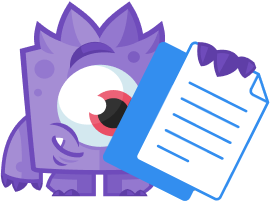Google Analytics 4 (GA4), originally called “Mobile + Web,” made its debut in October 2020. GA4 is the latest kind of Google Analytics property at the time of writing.
Note: As of October 14, 2020, GA4 properties are the default property type when you create a new Google Analytics property.
What’s the big difference between GA4 and UA properties? As the original name “Mobile + Web” implies, GA4 supports website and mobile app analytics. Where UA only worked on website analytics.
This document covers the other main differences between GA4 and its predecessor, Universal Analytics (UA). The content below is meant for people already familiar with Google Analytics UA properties yet haven’t got started with GA4.
After reading this article, you’ll know:
- How to tell the difference between a GA4 and a UA property.
- How GA4 records or organizes analytics compared to UA (i.e., data model differences).
- How GA4 reports are structured (e.g., changes side navigation menu).
- Which features are found in UA properties that aren’t in GA4.
- What brand new features GA4 introduces.
- What discrepancies exist in GA4 and UA reports when Dual Tracking.
Let’s get to it!
GA4 Measurement ID Versus UA Tracking ID
The easiest way to figure out whether you’re looking at a GA4 or a UA property is by the “tracking” ID.
GA4 properties have a Measurement ID. A Measurement ID starts with a capital G and a hyphen (G-) followed by a string of up to 10 characters. These characters can be numbers and letters.
Format: G-XXXXXXXXXX
Example: G-NVMH1T3GEK
To find your GA4 Measurement ID, go to Admin » Property » Data Streams. Click on a data stream. The Measurement ID shows up in the stream details after the Stream URL and Stream Name.

UA properties use a Tracking ID instead of a Measurement ID. The Tracking ID begins with a capital UA and a hyphen (UA-) followed by 7 numbers and a trailing hyphen and number (-X). The trailing number is a sequential number starting from 1 that maps to a specific property in your Google Analytics account.
Format: UA-XXXXXXX-X
Examples: UA-1234567-1, UA-1234567-2, UA-1234567-3
The examples above show what the tracking IDs would look like if there were 3 properties tied to the same Google Analytics account.
You can find the Tracking ID for a UA property under Admin » Property (column) » Property Settings » Tracking Id.
Side Menu Changes
The GA4 homepage still has a side navigation bar (navbar). The big change is that there are only 4 high-level menu items, and they’re shown as icons by default (collapsed view). When you hover over the navbar, it expands to reveal the menu names. On top of that, the second-level menu items have sub menu items that can expand to reveal 2 more levels of menus (a total of 4 levels).
Here are the 4 high-level menu items.
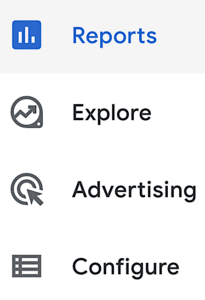
In GA4, you’ll see the following familiar UA high-level menu items in new locations:
- Realtime: now under Reports
- Audience(s): now under Configure
- Acquisition: now under Reports » Life cycle
- Conversions: now under Configure
- Admin
Besides the new high-level menu items, you’ll discover other menu items new in GA4, such as:
- Reports snapshot
- Engagement
- Monetization
- Retention
- Library
- Custom definitions
- DebugView
Changes to the Data Model
Events Versus Hit Types
Everything’s an event in GA4. GA4 doesn’t have any concept of a hit type like UA uses.
Hit types are the foundation of how UA properties handle all stats. Not having hit types in GA4 difference is nothing short of a monumental paradigm shift.
Understanding GA4’s event data model may take some getting used to. But, the quicker you begin to grasp that everything’s an event in GA4, the easier it is to work with GA4 properties.
The table below shows how UA hit types are all mapped to GA4 events, courtesy of Google:
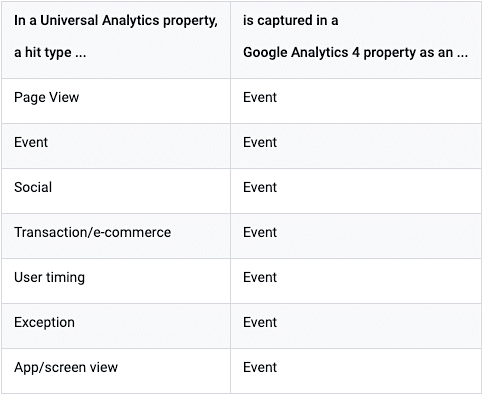
GA4 Event Categories
GA4 organizes events into 4 categories:
- Automatically collected
- Enhanced measurement
- Recommended
- Custom
Google recommends using events from these 4 categories in the above order. That means if you don’t see an event type you need in the first 3 categories (i.e., Automatically collected, Enhanced measurement, and Recommended), then create a custom event.
When would you need to create a custom event? If you want to track menu clicks, then creating a custom menu click event is a good example. That’s because there’s no menu click event in the first 3 event categories at the time of writing.
Let’s review each category in more detail.
1. Automatically collected
As the name suggests, GA4 automatically collects these events. You don’t have to do anything to activate these events. There’s no setting to turn on, and there’s no code for you to write.
Here are some examples of automatically collected events.
- first_visit – the first visit to a website or Android instant app
- session_start – the time when a visitor opens a web page or app
- user_engagement – when a session lasts longer than 10 seconds or had 1 or more conversions or had 2 or more page views
Learn more about automatically collected events by visiting the Google Analytics help docs.
2. Enhanced measurement
GA4 allows you to turn on enhanced measurement to get an extra set of automatically collected events. You don’t need to write code to get these extra events. But, you’ll need to enable the Enhanced measurement setting in your Data Stream.
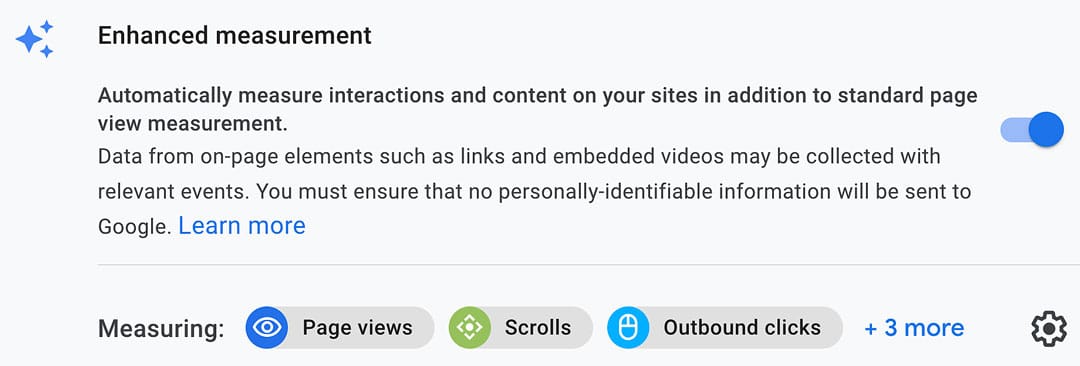
Here are some of the available enhanced measurement events.
- page_view: a page-load in the browser or a browser history state change
- click: a click on an outbound link (i.e., a click that goes to an external site)
- file-download: a click that triggers a file download, such as downloading a PDF file
- scroll: the first time a visitor scrolls to the bottom of a page (i.e., viewed 90% of the page)
See the full list of enhanced measurement events on the Google Analytics help page.
3. Recommended
Recommended events are events that aren’t implemented in GA4. If you need an event that’s not collected automatically or in the enhanced measurement, you should check to see if what you need is in the recommended events. If it is, then follow the guide for that recommended event. That makes sure that the recommended event you created is compatible with future GA4 releases.
Examples of recommended events include login, purchase, and sign_up.
Learn more about recommended events by visiting the Google Analytics help page.
4. Custom
As mentioned earlier, custom events are your last option when you need to track an event that doesn’t fall into the first 3 categories.
You’ll need to design and write custom code to implement the custom event you want to track. And, there’s no guarantee that Google will support your custom events in the future.
Google recommends consulting their developer’s documentation when writing code to create custom events.
Writing code to create a custom event should not be confused with creating a custom event from the triggering of an existing event.
Hello Data Streams; Goodbye Views
Google defines a data stream as:
“A flow of data from your website or app to Analytics. There are 3 types of data stream: Web (for websites), iOS (for iOS apps), and Android (for Android apps).”
Instead of views (from UA), GA4 has data streams. Be careful—it’s tempting to think a GA4 data stream is analogous to a UA view. They’re not analogous.
A GA4 data stream is not a replacement for a UA view. The only real resemblance is the website URL setting. In GA4, you connect your website’s URL to a data stream. In UA, connect your website’s URL to a view.
If you remember, UA views are mainly for filtering data. For example, you can create a filter in a UA view to exclude certain IP addresses from reports.
You cannot create a filter in a GA4 data stream. But, you can do the following in a data stream:
- Set up a list of domains for cross-domain tracking
- Create a set of rules for defining internal traffic rules
- Put together a list of domains to exclude from tracking
The big thing to remember about a data stream is that this is where to go for:
- Finding your measurement ID
- Enabling enhanced measurement (e.g., page views, scrolls, outbound clicks)
- Getting your global site tag code snippet
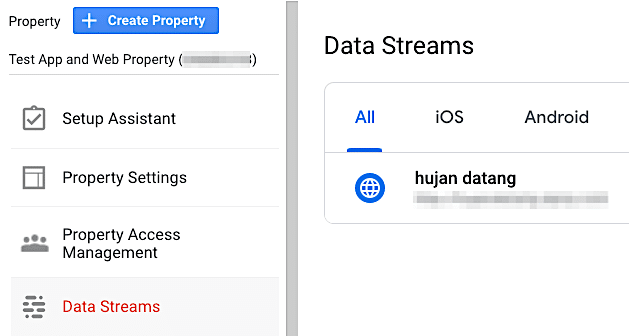
There are 2 things to watch out for with data streams.
- There’s no way to edit a data stream after it’s created.
- Deleting a data stream can’t be undone.
User ID Tracking Made Easy
Turning on user ID tracking in GA4 is a breeze compared to UA.
Simply finding where the user ID setting in UA is a challenge. Once you find it, you have to jump through a few hoops to get user ID tracking working (not to mention setting up the user ID custom dimension).
In GA4, all you need to do is:
- Go to Admin > Property > Default Reporting Identity
- Click By User-ID and device
- Click Save
What’s Missing in GA4
Here’s a summary of what’s not in Google Analytics 4 but what is in Universal Analytics.
Views and Filters: You can’t create a view in GA4 like you can in UA. So it follows that you can’t create filters since filters are created in views. For properties that were converted from UA to GA4, there is a read-only list of UA filters under Admin > Account > All Filters.
Customization (menu): UA properties have a customization menu for options to create dashboards, create custom reports, save existing reports, and create custom alerts. Below are the UA customization options, along with their GA4 equivalent.
- Dashboards: There isn’t a way to create a custom GA4 dashboard at the time of writing.
- Custom reports: GA4 has the Explorations page instead. The Explorations page is where to go for creating custom reports in GA4.
- Saved reports: Each report you create in Explorations is automatically saved.
- Custom alerts: You can create alerts inside custom Insights from the GA4 home page. Creating custom Insights is a new GA4 feature.
AMP: AMP tracking only works with UA properties at this current time. Google has yet to support it in GA4, so therefore, this data will not appear in GA4 reports.
Bounce rate: Don’t try to find a bounce rate metric in a GA4 property because there isn’t one. Popular articles and forum posts that suggest GA4 engagement metrics have replaced UA’s bounce rate.
Conversion Goals: Conversion goals fall under views in UA. Since there aren’t views in GA4, there’s no more option for creating conversion goals. Not to fear. GA4 lets you flag or mark an event as a conversion. This is essentially the same thing as creating a conversion goal in Universal Analytics.
What’s New Only in GA4
Create and modify events: Yes. You read that right. You can create a custom event and modify events (for web) right within your GA4 property. This isn’t possible for Universal Analytics properties without writing code. Get more details on the Google event help page.
Create and mark conversion events: Instead of creating a conversion goal, you can mark and unmark an event as a conversion with a flip of a toggle. You can also create new conversion events ahead of time before those events actually take place.
Data filters: You can set up data filters that allow you to either include or exclude traffic internal and developer traffic from your GA4 reports.
Data streams: See the section on data streams above for the details.
Explorations and Template gallery: Under the new Explore menu section is the Explorations page and Template gallery. Explorations is where to go for creating an Exploration.
An Exploration and a report are not the same things in GA4. An Exploration is meant to give you a deeper understanding of your data. You can use metrics and dimensions not available in reports to construct views to give you different perspectives on your property’s traffic.
All the report templates available for Explorations are kept in the Template gallery. But, you can scroll through the templates and select them directly from Explorations via a handy thumbnail slider.
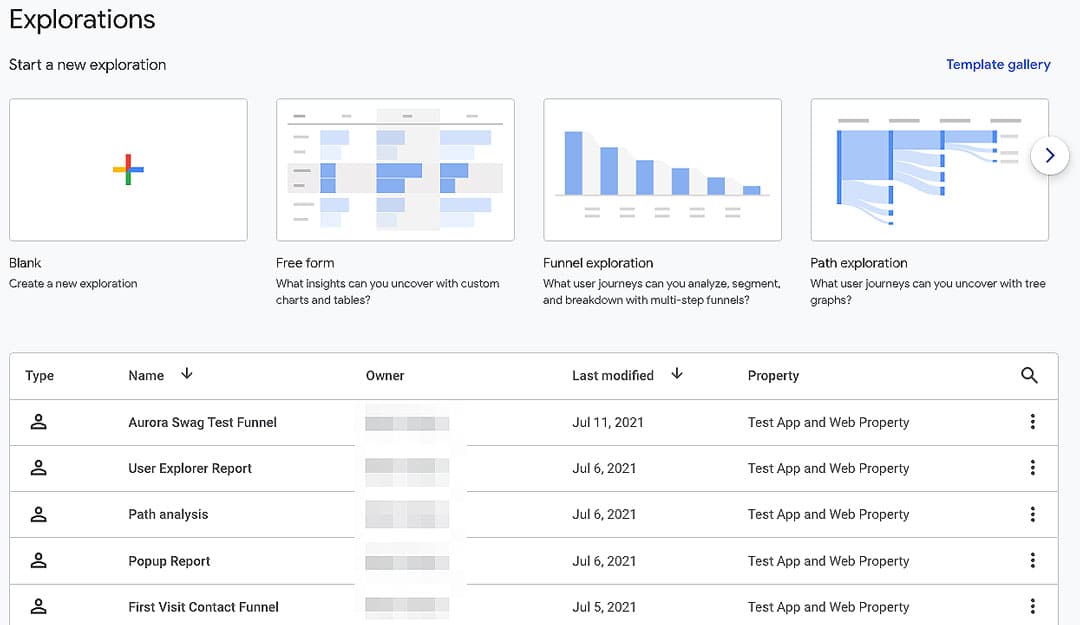
DebugView: GA4 now comes with a built-in visual debugging tool. This is exciting news for developers and business owners alike. You still need to turn on Google Analytics debug mode on your device or browser for the DebugView to work.
When debug mode is turned on, you’ll be rewarded with a real-time view of events displayed on a vertical timeline graph. There are 2 vertical “streams” of events:
- Minutes: Shows events for the past 30 minutes.
- Seconds: Shows events for the past 60 seconds. You can click on the seconds stream to pause it.
You’ll also get a report of the top events for the last 30 minutes and the user properties for the device or browser that’s on debug mode.
DebugView is found under the Configure section of the top-level menu. Learn more about the new DebugView on Google’s help page.
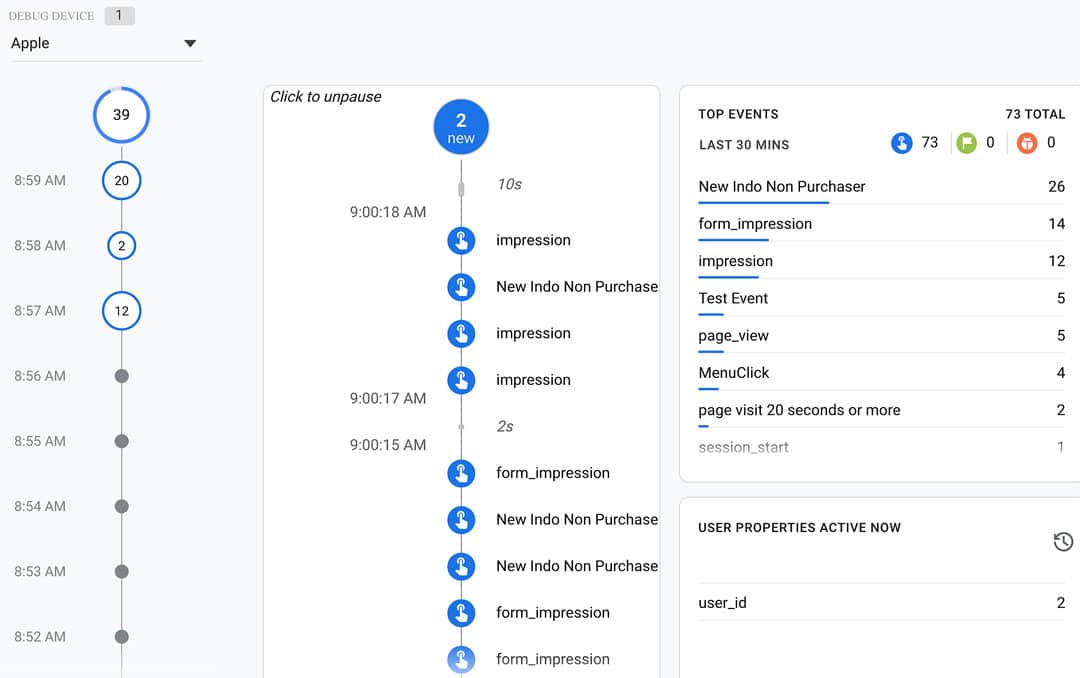
BigQuery linking: Google’s BigQuery is a “Serverless, highly scalable, and cost-effective multicloud data warehouse designed for business agility.” If you have a BigQuery account, you can link that account to your GA4 property. Once your GA4 property is linked to your BigQuery account, you can run business intelligence tasks on your property’s analytics using BigQuery tools.
Learn more about BigQuery linking on Google’s help page.
Analytics intelligence search history: You now have the ability to delete search queries from your search history. This is helpful because Google Analytics Intelligence uses your search history to help fine-tune searches and recommendations. You can find your search history under Admin > Property > Additional Settings.
Differences in GA4 and UA when Dual Tracking
If you’ve set up dual tracking to use both a GA4 and UA property to track site performance, you’ll notice differences between your GA4 and UA reports when comparing numbers.
UA reports show higher amount of sessions than GA4
Sessions are calculated differently between GA4 and UA. If you are seeing nearly double the amount of sessions in your UA property than your GA4 property, this is most likely the result of how Google is handling this metric.
For more information, please see Google’s guide here: [GA4] About Sessions – Differences from Universal Analytics.
Realtime reports show different numbers between GA4 and UA
If you’re finding the Realtime report in your UA property seems lower than expected, Google recommends viewing your GA4 Realtime report for the most accurate real-time data:
You may notice low realtime data in the Real-Time report in your Universal Analytics property when you first open the report. We recommend waiting a few minutes to see accurate numbers in Universal Analytics Real-Time reports, but to get the most accurate realtime data, we recommend that you use the Realtime report in a Google Analytics 4 property.
For more information, please see Google’s guide here: About Real-Time.
